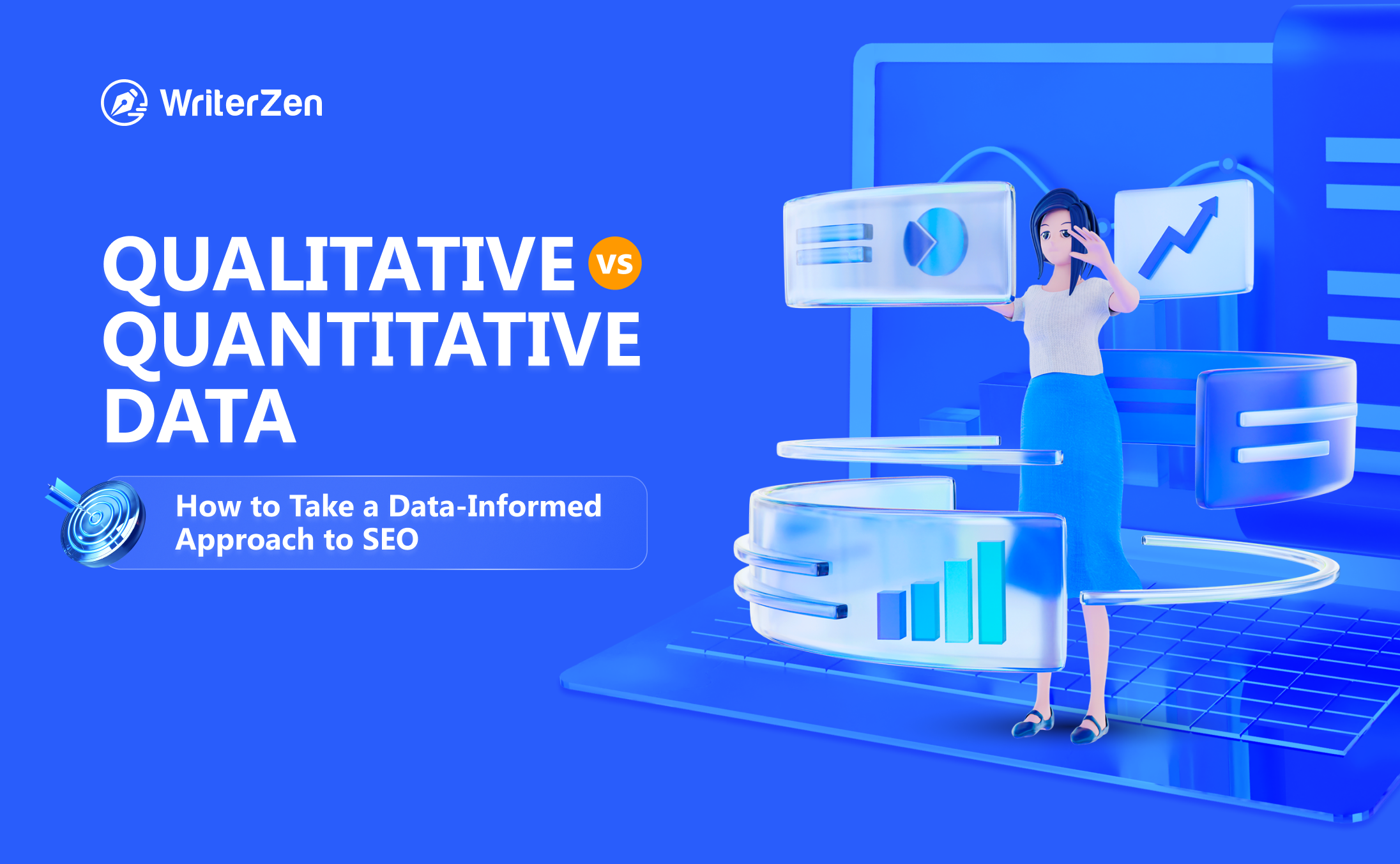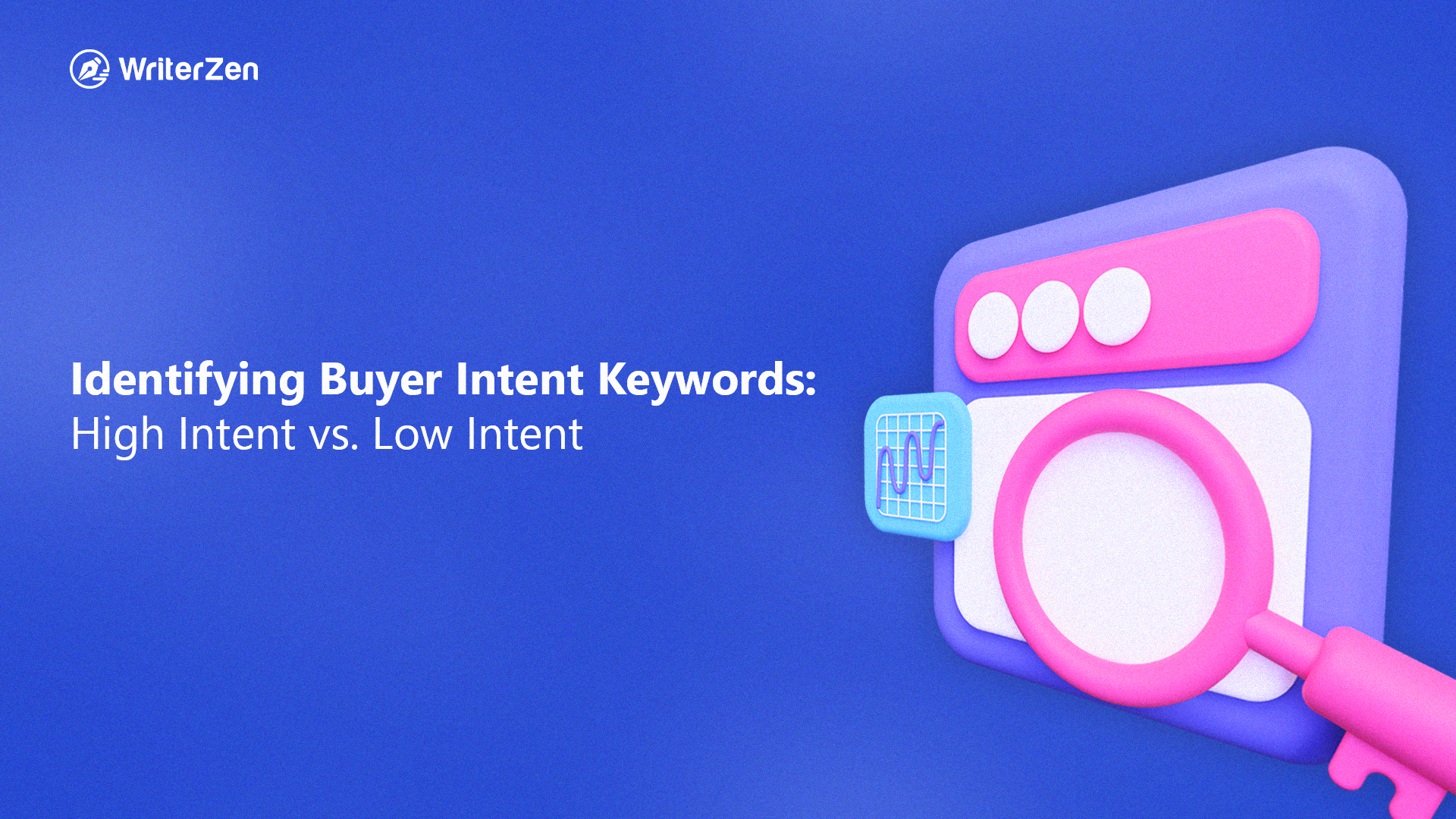SEO specialists and marketers are swimming in a wealth of information. However, they often struggle to make sense of this valuable data and uncover opportunities they can take advantage of.
Because the data sample isn't right, and there's a problem with its quality. For example, Google Analytics is often used for low-ROI metrics such as page views. Ignoring the other important factors, relying solely on keyword difficulty, would result in misleading outcomes.
Essentially, these are nice numbers to look at but not actionable enough to provide valuable insights. In a lot of cases, SEO strategies created using unactionable, flawed data provided ineffective outcomes and missed chances for success.
So in this article, we will bring light to inaccurate data quality issues and how Marco Giordano, a Web Analyst at Sika, resolves them by taking a data-informed approach to SEO strategy.
Is Data Inaccuracy a Major Issue?
As a part of your job, you collect keyword data from a variety of third- and second-party sources. Then analyze this data to provide useful insights for your managers, clients, or potential customers. Done and dusted.
But is it as simple as just using a few tools and some analysis tricks?
Each keyword tool works in its own unique way, gathering and handling data differently. Comparing data from different tools can show inconsistency — not only in the numbers but also in how they present the results.
Just like you, the main challenge for other SEOs and marketers is to determine whether the keyword data they're using is correct. So how do you find that out?
Google is the only one that has access to the exact data values.
If we want to make good use of Google Analytics, we need data that are neat, accurate, and split up to show us the traffic that matters most. Checking the accuracy of Search Console data can be a bit of a headache, too.
Then comes third-party keyword tools, like SEMrush, Ahrefs, and Keywordtool.io, that don't really tell us much about how they gather, group, or handle their data.
So, you need to be careful about how you understand the data from these tools and deal with any errors or inconsistencies.
Marco Giordano shares his unique stance on this matter.

He said, “The lack of exact data, interestingly, doesn't always pose significant obstacles. For instance, if I need to understand the exact search volume of a specific keyword, I know that I won't be able to obtain that precise figure. However, I can estimate its volume based on the data I have. If a keyword shows a volume of two hundred, I can consider that number as a minimum threshold. In all likelihood, the actual volume is substantially higher.”
“In my experience, this perceived challenge isn't a significant hurdle in certain scenarios. Take, for example, keyword research, particularly in B2B industries. Here, the focus isn't so much on the sheer search volume but more on addressing the specific issues that users face. So, in such situations, data inaccuracy isn't a grave concern as long as you're capable of interpreting the data you have. But for publishers whose primary revenue comes from display ads, accurate traffic data becomes crucial.” adds Marco.
The Importance of Data-Informed Decisions in SEO
Data often lets you know your customer better and helps you make the most accurate decision, if not always.
There’s a difference between data-driven and data-informed strategy.
When it comes to using analytics data, there’s no point in only analyzing them. Because an analysis won't prove anything, you can't demonstrate why something is true.
“Data alone doesn't give you superpowers, you still need your comprehension and business acumen,” notes Marco.
Simple observations mean nothing, as they can be misleading and inconsistent.

In a data-driven approach, decisions are based solely on the data that has been collected and analyzed.
Here, data is the primary and often the only determinant in making decisions. Every action is backed by what the numbers are saying, and less quantifiable factors are often ignored.
For SEO, a data-driven approach would include analyzing metrics such as click-through rates, keyword ranking, and backlink profiles to drive decisions about content creation, website structure, and link-building strategies.
On the other hand, a data-informed approach in SEO involves using data as an essential component in decision-making, but it does not dominate the entire decision-making process.
In a data-informed strategy, data provides insights that guide decisions, but these decisions also include other factors such as intuition, experience, and the unique context of the business.
The data-informed approach might involve studying data on keywords, site traffic, and bounce rates, but it also considers factors such as user experience, website design, and content quality which might not be quantifiable.
Sourcing credible qualitative and quantitative data is the initial stride toward a data-informed approach.
What Are Qualitative and Quantitative Data? Why Do You Need Them?
Quantitative data can be counted, measured, and expressed using numerical values. Qualitative data is descriptive and conceptual. Qualitative data can be categorized based on traits and characteristics.
In simple terms, the main difference is that quantitative data is set in stone or the same for everyone, while qualitative data can change based on who's looking at it. Now that we have the differences, let's dive into each data type and how we can obtain them.
Quantitative Data
Quantitative data is primarily concerned with numerical values and measurable quantities. It revolves around objective information and statistical analysis, focusing on the surface-level aspects of a given subject.
When dealing with quantitative data, the emphasis is on crunching numbers and extracting meaningful insights from the numerical values.
This type of data analysis often involves statistical techniques to identify patterns, trends, and correlations, and other statistical measures. The goal is to obtain quantitative measurements that can be used for decision-making and evaluating performance.
For instance, in the context of a website, quantitative data analysis may involve analyzing the number of backlinks to the site, as well as tracking sales figures and page views.
By examining these numerical metrics, website owners can assess the effectiveness of their marketing strategies, identify areas for improvement, and make data-driven decisions to increase backlinks, sell more products, generate more page views, and enhance visitor interaction.
Below are some real-world examples of quantitative data.
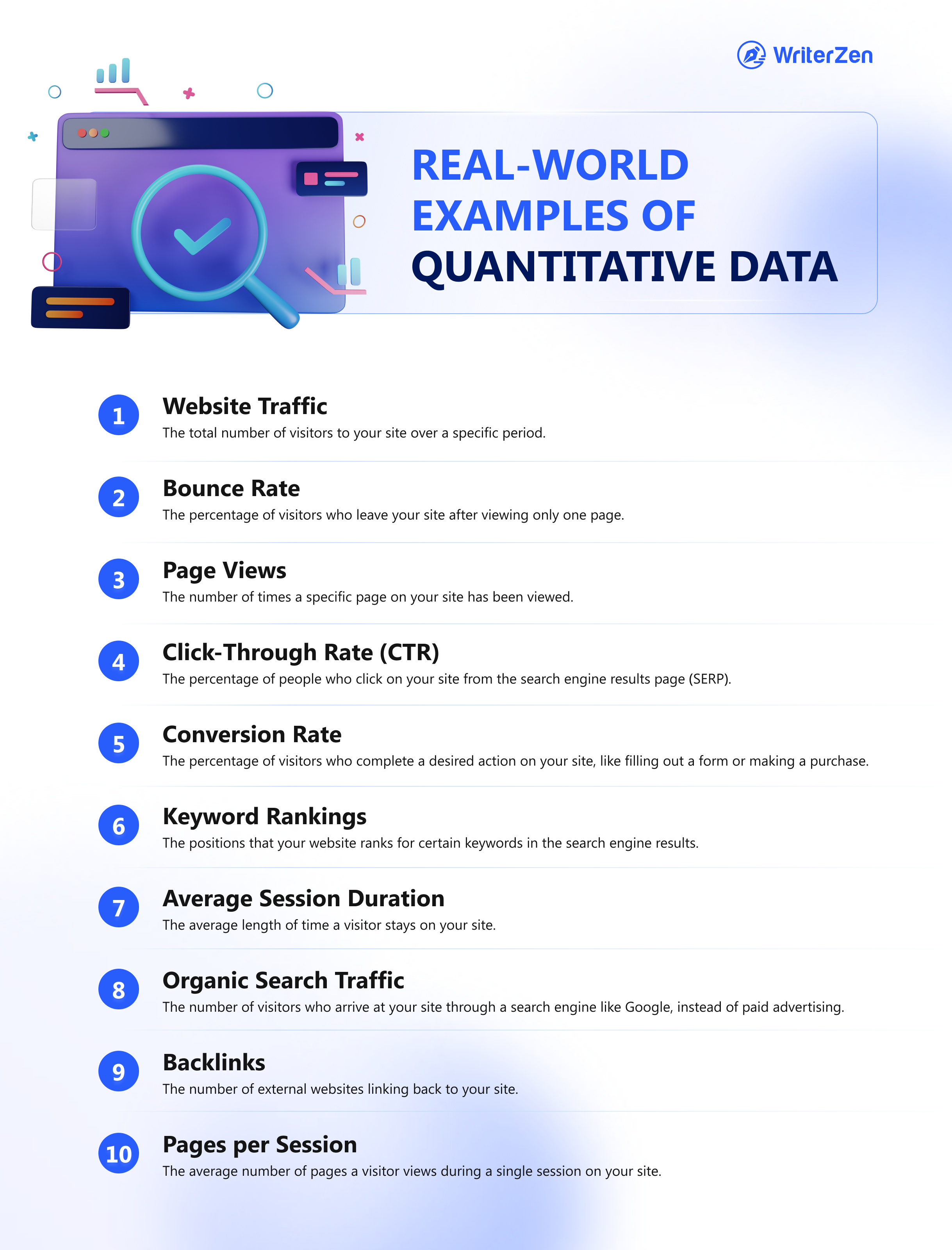
Qualitative Data
Qualitative data is a type of information that is focused on interpreting and understanding specific qualities rather than numerical measurements. It provides a deeper, more subjective understanding of a topic, adding context and detail that quantitative data often miss.
This kind of data helps researchers to comprehend human behavior and the reasons behind such behaviors, painting a comprehensive picture of a research subject. Hence it’s organized by traits, characteristics, labels, and other markers.
It's more about getting an in-depth understanding of a topic or issue rather than gathering hard facts or statistics.
So, instead of answering questions like "How many?" or "How much?", qualitative data answers "Why?" and "How?".
Qualitative data isn't about stats or numbers that you can plot on a graph or chart. Rather, it's usually unstructured or semi-structured, meaning it doesn't fit neatly into preset categories or formats.
It can come from many sources, like interviews, surveys with open-ended questions, observations, or documents.
Some real-world examples of qualitative data are:
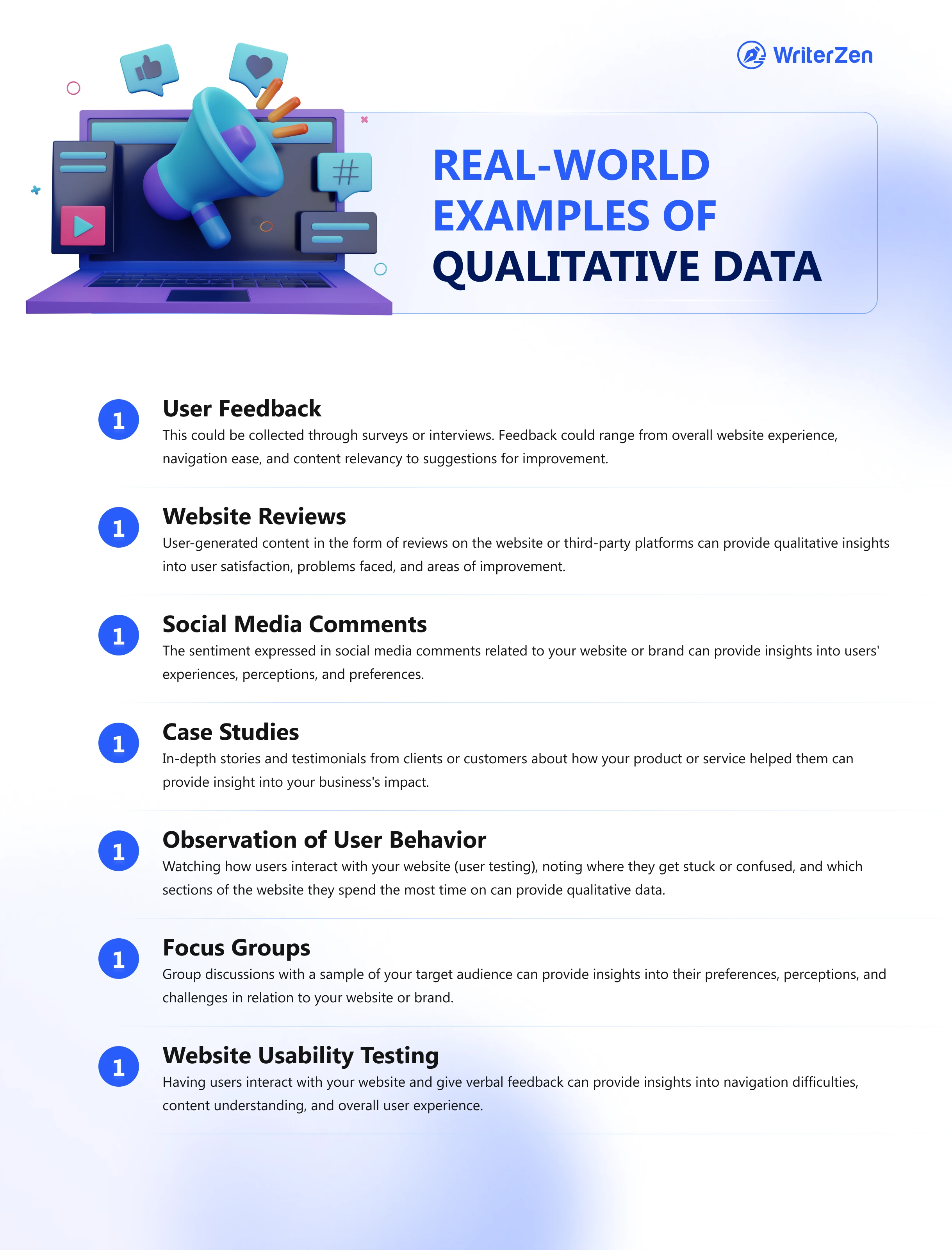
Qualitative Data vs. Quantitative Data
Qualitative data is information that isn't just about numbers. Researchers use it to deeply understand how people see and make sense of the world around them.
In contrast to quantitative data, qualitative research focuses on the content itself rather than relying solely on numerical values.
Qualitative research methods involve gathering descriptive and subjective data, such as interviews, observations, and open-ended survey responses, to gain insights into people's thoughts, experiences, and opinions.
Here’s a table that extensively compares both data types:
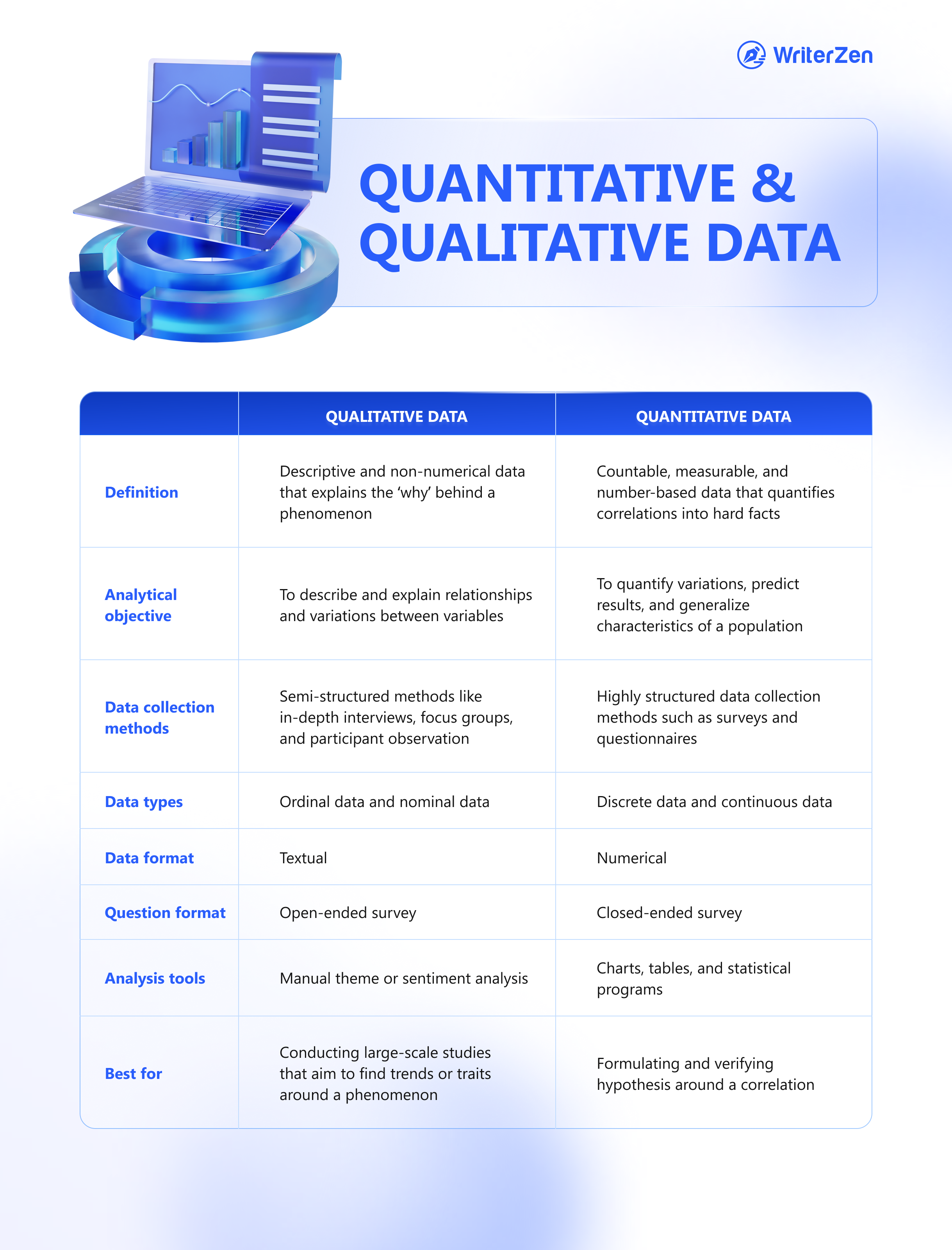
Credit: G2
Qualitative and quantitative data are incredibly valuable for research, scrutinization, and considering the broader perspective.
What’s more?
They not only equip you with unique perspectives and angles but also tools to deepen your understanding of any problem and validate your decisions.
Combining Qualitative Data and Quantitative Data to Approach a Data-Informed SEO Strategy
Can we say qualitative data is more important than quantitative data?
Then the answer is no.
“You need both, especially depending on what you want to achieve, your goal, your budget,” emphasizes Marco.
In many cases, depending on the website size, you can get a lot of insights from Search Console data, especially for B2C companies.
However, in the case of B2B companies, you need more advanced and nuanced data like user feedback and user behavior observation to be able to take a data-informed approach.
But extracting meaningful and insightful data can be a laborious and time-consuming process. Additionally, you need to have the knowledge and expertise to interpret the data and use the insights in a meaningful way.
WriterZen has integrated D.E.P.T.H (Data Exploration Provides Tactical Highpoints) into the Keyword Planner tool. This solution goes beyond the traditional method of analyzing SEO data. D.E.P.T.H streamlines the process of manual data analysis, making it accessible and easy for SEOs of all levels.
You only have to use it once to understand how sub-optimal your previous keyword research has been.
So what are you waiting for? Gather, organize, and use data seamlessly – try WriterZen’s Keyword Planner.


